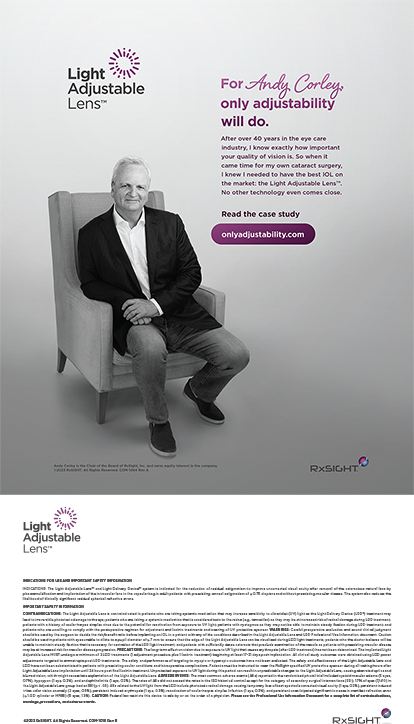The FDA approved the excimer laser for vision correction about 17 years ago. Since then, the technology has exploded, outcomes have improved, and millions of patients have experienced life without glasses and/or contact lenses.
The ubiquity of LASIK has made patients' expectations for cataract surgery more demanding. Excellent laser vision correction skills are thus important for anterior segment ophthalmologists whose cataract patients have not achieved the results they expected. Anterior segment surgeons must either learn to enhance their IOL patients or establish an arrangement with a refractive surgeon. This article shares a few tips on achieving excellent results with laser vision correction.
No. 1. REMAIN EXCITED
Complacency about the wonderful, life-changing work ophthalmologists do is the practice's death knell. Surgeons help people achieve visual independence and change their lives, yet ophthalmologists often take these contributions for granted. Infuse your practice with positive energy by truly listening to your patients. At the 1-day postoperative visit, step into the room, and listen to the patient as if it were for the first time! This approach will generate enthusiasm and energy that will spread to your staff.
No. 2. STANDARDIZE PROCEDURES
Break down the steps of your surgical procedure, and aim to standardize them. This effort will help your staff anticipate your needs, facilitate staff training, decrease mistakes, and, ultimately, improve outcomes.
No. 3. ADOPT NEW TECHNOLOGY
Adopting technology to replace manual methods allows for more precise surgery as well as fewer errors. I used to quote a flap complication rate of 1/250 to 1/1,000 in the microkeratome days.1 With the introduction of the Intralase FS60 (Abbott Medical Optics Inc.) into my practice years ago, my rate of flap-related complications essentially became nil. Similarly, switching to the company's fifth-generation iFS improved my early outcomes as well as efficiency.
No. 4. REFINE YOUR SURGICAL TECHNIQUE
Residual refractive error is a major cause of patients' postoperative dissatisfaction, so do not hesitate to perform an enhancement if the patient understands the risk-benefit ratio. Continually refine your surgical technique, but do so in a scientific fashion so that you can identify the step (or steps) that produced the improved result. Drs. Daniel Durrie, Karl Stonecipher, and Stephen Slade, and I have been studying early visual recovery after LASIK with the Nexis Shield (Nexis Vision; Figure 1). Using the shield, 93% of patients could text immediately after surgery, and 100% could do so by 30 minutes (Figure 2). Evaluating visual results immediately after LASIK through 4 hours postoperatively led us to introduce less fluid under the stromal flap during LASIK flap replacement and to instill nonpreserved topical moxifloxacin (Vigamox; Alcon Laboratories, Inc.) at the end of the procedure.
The reason for less fluid irrigation under the flap is the fact that the bare stroma is like a sponge and swells significantly with fluid. Less fluid placement means less time for the endothelial pump to work to restore the cornea to its normal thickness after LASIK. Preservatives such as benzalkonium chloride are known to wreak havoc on the corneal epithelium, so why not introduce less chemical toxicity to the corneal epithelium at the time. All in all, the combination of a shield plus a few other changes, some of which have been outlined previously, make it easier for the eye to recover from LASIK. This leads to better vision earlier!
No. 5. CREATE AN EXPERIENCE
Shareef Mahdavi, president of SM2 Strategic, Inc., is an expert at helping increase consumers' demand for new medical devices and procedures. He has discussed extensively the experiences for which people are willing to pay. For refractive cataract surgeons, that means achieving “20/happy” patients. Results need to meet the expectations of the patient, and that means creating a positive association for patients. To grow the brand for which people pay, it also involves creating the kind of experience that will cause patients to willingly recommend you to their family and friends. LASIK and premium cataract surgery are noncovered services. Patients act as consumers, so surgeons and staff need to appreciate patients' business.
The “wow” for patients has never really left LASIK. You and your staff need to remain excited about your patients' results. Revisit and standardize your procedures, adopt new technology for more precise outcomes, and ultimately, create a better vision experience for your patients. Have fun providing great vision!
Sandy T. Feldman, MD, is the medical director of Clearview Eye & Laser Medical Center in San Diego. She has a financial interest in Nexis Vision. Dr. Feldman may be reached at (858) 452-3937; sfeldman@clearvieweyes.com.
- Tham VM, Maloney RK. Microkeratome complications of laser in situ keratomileusis. Ophthalmology. 2000;107(5):920-924.


